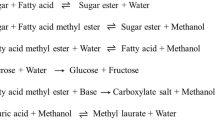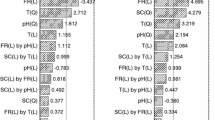Abstract
A simple rate-based method is proposed for recovering sucrose from sugarcane molasses, focusing on its feasibility for continuous recovery. When ethanol is gently poured onto diluted molasses, sucrose is transferred to ethanol layer along with water, resulting in the formation of a distinct third layer comprising sucrose positioned between the ethanol and diluted molasses. Although this third liquid layer is metastable and dissipates when vigorously stirred, its sucrose concentration reaches a level suitable for sucrose crystal formation. Consequently, a semicontinuous operation for sucrose recovery from diluted molasses is achieved by continuously extracting the third layer while supplying ethanol to the diluted molasses. The concentration changes of sucrose within the third liquid layer over time are predicted using simple mass-transfer models based on diffusion and axial dispersion. While the prediction yields limited success, it underscores the importance of mass transfer from the liquid jet in the third layer and the role of mild mixing within the third layer in facilitating its growth and interior mass transfer. To the best of our knowledge, this study presents the first effective utilization of the third liquid layer in solvent extraction offering a method to control its formation and mass transfer for sugar recovery from molasses.












Similar content being viewed by others
References
Adinata, D., F. Fadillah, R. Hafiz, S. Bismo, S. Kartohardjono, and Y.W. Pratama. 2013. Characteristics of sugar separation from cane molasses using vegetable oil, n-butanol, and n-hexanes solvent in the simple tube sieve tray extraction column, International Conference on Food and Biosystems Engineering, 30 May-02 June 2013, Skiathos Island, GREECE.
Asadollahi, S., and M.H.H. Khodaparast. 2013. Optimization of molasses desugarization process using Steffen method in sugar beet factories. International Journal of Science and Innovative Research. 7 (11): 1063–1069.
Hongisto, H.J. 1977. Chromatographic separation of sugar solutions. The Finnsugar Molasses desugarization Process. Part I. International Sugar Journal 79(940): 100–104.
Iqbal, K., 1992. Recovery of sugars from cane molasses by continuous simulate moving bed ion-exclusion chromatograph. PhD dissertation to Louisiana State University.
Kanno, S., S. Meguro, and R. Kanda. 1980. Desugaring process of molasses at Kitami factory (in Japanese). Proceedings of the Research Society of Japan Sugar Refineries Technologists. 29: 79–87.
Ke, X., and X. Ping. 2014. Efficient production of L-lactic acid using co-feeding strategy based on cane molasses/glucose carbon sources. Bioresource Technology. 153: 23–29.
Kononenko, O.K., and K.M. Herstein. 1956. Nonaqueous solvent for sucrose. Industrial & Engineering Chemistry Research. 1 (1): 87–92.
Lameloise, M.-L., and R. Lewandowski. 1994. Purification of beet molasses by ion-exclusion chromatography: Fixed-bed modelling. Journal of Chromatography a. 685 (1): 45–52.
Luo, J., S. Guo, Y. Wu, and Y. Wan. 2018. Separation of sucrose and reducing sugar in cane molasses by nanofiltration. Food and Bioprocess Technology. 11: 913–925.
Moo-Young, J., P. Bu-Soo, L. Jinwon, and O. Min-Kyu. 2013. Engineered Enterobacter aerogenes for efficient utilization of sugarcane molasses in 2,3-butanediol production. Bioresource Technology. 139: 21–27.
Mouadili, H., S. Majid, O. Kamal, El.H. ElAtmani, K. Touaj, L. Lebrun, and M. Hlaibi. 2018. New grafted polymer membrane for extraction, separation and recovery processes of sucrose, glucose and fructose from the sugar industry discharges. Separation and Purification Technology. 200: 230–241.
Olbrich, H. 1963. The Molasses. Berlin: Institut für Zuckerindustrie.. Reedition Biotechnologie-Kempe GmbH 2006. http://www.btkempe.de/Molasses_OLBRICH.pdf, 9.12.2010.
Rouanne, F. 1991. Method for metering monocalcium saccharate into sugar juices, United States Patent, patent number 5104452.
Simao, P.P., and A.M. Eugenia. 2005. Solubility of NaCl, NaBr, and KCl in Water, Methanol, Ethanol, and their mixed solvents. Journal of Chemical & Engineering Data. 50: 29–32.
Sjölin, M., J. Thuvander, O.Wallberg, and F. Lipnizki., 2020. Purification of sucrose in sugar beet molasses by utilizing ceramic nano filtration and ultrafiltration membranes. Membranes. 10(5). https://doi.org/10.3390/membranes10010005
Thompson, M. 1994. The potential application of ion exclusion chromatography for additional sucrose recovery from molasses. Proceedings of The South African Sugar Technologists' Association. June 1994, 105–108.
Walid, A.L. 2007. The utilization of beet molasses as a novel carbon source for cephalosporin C production by Acremonium chrysogenum: Optimization of process parameters through statistical experimental designs. Bioresource Technology. 98: 3491–3498.
Yang, Q., J. Luo, S. Guo, X. Hang, X. Chen, and Y. Wan. 2019. Threshold flux in concentration mode: Fouling control during clarification of molasses by ultrafiltration. Journal of Membrane Science. 586 (15): 130–139.
Acknowledgements
Sample molasses was kindly provided from sugar companies in Kagoshima prefecture.
Author information
Authors and Affiliations
Contributions
TO was involved in conceptualization, investigation, data curation, writing—original draft. HA contributed to conceptualization, methodology, and discussion. KM contributed to investigation. SN contributed to writing—review and editing and supervision.
Corresponding author
Ethics declarations
Conflict of interests
We certify that all our affiliations or financial involvement with any organization or financial conflict with the subject matter discussed in the manuscript are completely disclosed in the acknowledgement section of the manuscript.
Additional information
Publisher's Note
Springer Nature remains neutral with regard to jurisdictional claims in published maps and institutional affiliations.
Rights and permissions
Springer Nature or its licensor (e.g. a society or other partner) holds exclusive rights to this article under a publishing agreement with the author(s) or other rightsholder(s); author self-archiving of the accepted manuscript version of this article is solely governed by the terms of such publishing agreement and applicable law.
About this article
Cite this article
Otani, T., Ando, H., Mizuta, K. et al. Sucrose Recovery from Diluted Cane Molasses by Using Mass Transfer to the Third Liquid Layer at Contacting with Ethanol. Sugar Tech 26, 513–520 (2024). https://doi.org/10.1007/s12355-023-01354-0
Received:
Accepted:
Published:
Issue Date:
DOI: https://doi.org/10.1007/s12355-023-01354-0




